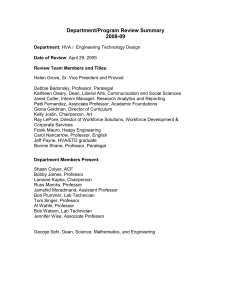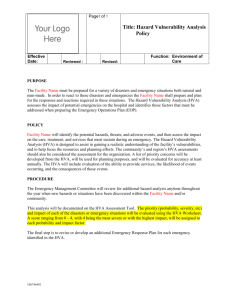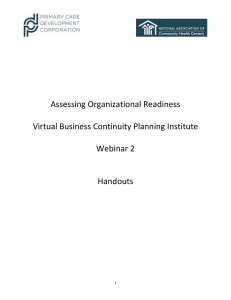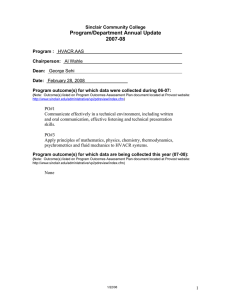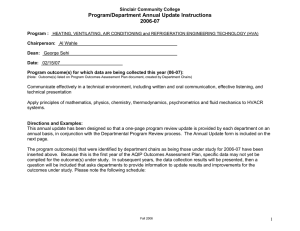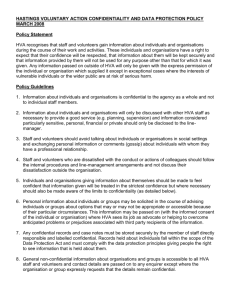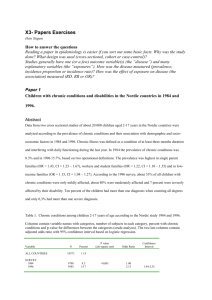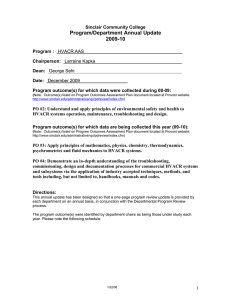Continuous Improvement Annual Update 2011-12 Sinclair Community College –
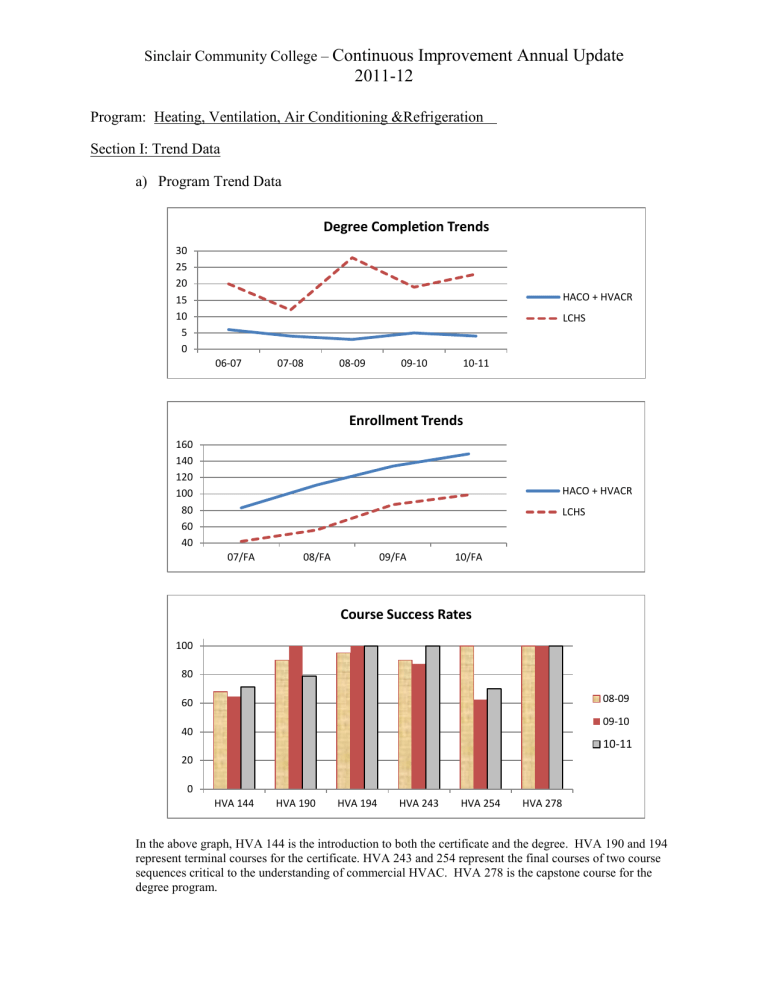
Sinclair Community College –
Continuous Improvement Annual Update
2011-12
Program: Heating, Ventilation, Air Conditioning &Refrigeration
Section I: Trend Data a) Program Trend Data
Degree Completion Trends
30
25
20
15
10
5
0
HACO + HVACR
LCHS
06-07 07-08 08-09 09-10 10-11
Enrollment Trends
160
140
120
100
80
60
40
HACO + HVACR
LCHS
07/FA 08/FA 09/FA 10/FA
Course Success Rates
100
80
60
40
20
0
08-09
09-10
10-11
HVA 144 HVA 190 HVA 194 HVA 243 HVA 254 HVA 278
In the above graph, HVA 144 is the introduction to both the certificate and the degree. HVA 190 and 194 represent terminal courses for the certificate. HVA 243 and 254 represent the final courses of two course sequences critical to the understanding of commercial HVAC. HVA 278 is the capstone course for the degree program.
Sinclair Community College –
Continuous Improvement Annual Update
2011-12
b) Interpretation and Analysis of Data
Suggestions of questions that might be addressed in this section: What trends do you see in the above data? Are there internal or external factors that account for these trends? What are the implications for the program or department? What actions have the department taken that have influenced these trends? What strategies will the department implement as a result of this data?
There has been a substantial increase in enrollment as a result of a large influx of displaced workers.
Enrollment in both the HVAC Associate Degree Program and the short-term certificate continue to rise, although there is probably substantial duplication in these numbers as many students receiving workforce retraining money declare for both the certificate and the degree with the intention of only completing the certificate. The program still tends to be a predominantly “white male” program, although
African-American enrollment averages around 25%. Female enrollment remains low in both programs averaging 2-4% per year. The average age of students in the degree program has been trending up, although the majority of students are still in the under 30 age group. While not large, the number of students over 50 has been trending up with more displaced workers.
Program completions have been reasonably stable. The HVACR.AAS program, which replaces the HACO program, had its first graduate in 07-08. Most students with a declared major code of HACO have graduated; there is but a handful left.
The enrollment in first year HVACR 2-year classes has increased recently. Historically, HVAC students have not completed degree graduation requirements citing lack of interest in taking their general education, mathematics, and science requirements. However, in recent years, department faculty continually emphasize the importance of life-long learning. This emphasis manifests itself primarily through required attendance (as part of select courses) of local ASHRAE meetings. Secondarily, use of industry guest lecturers and field trips to industry partners allow the student to ask specific questions that tend to validate not only the requirement to graduate, but also the necessity to continue one’s education after graduation.
Section II: Progress Since the Most Recent Review
a) What was the fiscal year of the most recent Program Review for this program?
2010-2011 b) Briefly summarize the goals that were listed in Section IV part E of the most recent Program Review
Self-Study (this section of the Self-Study asks “What are the department’s/program’s goals and rationale for expanding and improving student learning, including new courses, programs, delivery formats and locations”)?
Increasing delivery options for course materials
Increasing project-based learning in classes
Embedding new material as technology and the state of the profession changes c) Have these goals changed since your last Program Review Self-Study? If so, please describe the changes.
There is little emphasis on different delivery modes at this time. The sole exception is to use more industry published material (usually via the Internet), Internet-based material, and HVAC industry websites such as ASHRAE.org (Website of the American Society for Heating, Refrigeration, and Air
Conditioning Engineers) and the HPAC (Heating, Piping and Air Conditioning) Magazine website.
Sinclair Community College –
Continuous Improvement Annual Update
2011-12
Our primary emphasis does remain on the later two goals: project-based learning and the use of new and innovative materials. Project-based learning is the mainstay of our integrated capstone project.
We also continue to expand project-based learning within both of our HVAC control courses,
HVA 240 and HVA 243. In this later case, this expansion necessarily involves the incorporation of new control hardware and technology, our third goal. d) What progress has been made toward meeting any of the goals listed above in the past year?
Continued implementation of a multi-disciplinary integrated capstone (3 rd year of new format) including the requirement of maintenance of a personal journal (i.e.: project documentation) over the course of the capstone project.
Incorporation of the Tridium Niagara AX control platform into the first HVAC controls course,
HVA 240. Last year, the Tridium Niagara AX platform was introduced into our second HVAC controls course, HVA 243. This illustrated the need to introduce the technology much sooner. As such, HVA 240 is now benefiting from the introduction of this technology by introducing small, session length group projects involving the Tridium hardware. e) What recommendations for Action were made by the review team to the most recent Program Review?
What progress has been made towards meeting these recommendations in the past year?
1) Increased marketing of the HVAC programs is recommended. Currently the program is at about 67% capacity, thus an increase of 50% is achievable within current resources. Last year, there was a short-term weakening in the job market for our graduates. Although demand for graduates has not changed significantly from last year, it has risen to some extent. As such, more aggressive marketing of the HVAC programs (perhaps coupled with the energy program) is necessary. This is especially true since we have lost enrollment due to the loss of the ABC program and the Union upgrade program.
2) Need improved documentation of meeting general education outcomes and program outcomes
– complete assessment plans exist and these items are all being measured and assessed through the ABET Accreditation process. The review in the fall of 2010 had no negative findings.
Sinclair Community College –
Continuous Improvement Annual Update
2011-12
Section III: Assessment of Outcomes
The Program Outcomes for this program are listed below. At least one-third of your program outcomes must be assessed as part of this Annual Update, and across the next three years of these program outcomes must be assessed at least once.
Heating, Ventilation, Air Conditioning & Refrigeration
Program Outcomes
In which courses are these program outcomes addressed?
Which of these program outcomes were addressed during the last fiscal year?
1)
2)
Communicate effectively in a technical environment, including written and oral communication, effective listening, and technical presentation
Understand and apply principles of environmental safety and health to HVACR systems operation, maintenance, troubleshooting and design.
COM 206
CAT 139
CAT 202
ENG 111
ENG 112
ETD 198
ETD 199
HVA 253
HVA 254
HVA 272
HVA 276
HVA 278
HVA 184
HVA 186
HVA 250
HVA 254
HVA 276
HVA 278
3) Apply principles of mathematics, physics, chemistry, thermodynamics, psychrometrics, and fluid mechanics to HVACR systems.
MAT 131
MAT 132
PHY 131
EET 120
ETD 261
HVA 144
HVA 170
HVA 174
HVA 177
HVA 180
HVA 184
Assessment M ethods Used
Faculty and Advisory
Committee assessment of
HVA 278 Capstone
Course
Graduate Exit Interviews and employer surveys
Faculty review of student comments from course evaluations
Faculty and Advisory
Committee assessment of
HVA 278 Capstone
Course
Core competency survey at the time of graduation
Faculty review of student comments from course evaluations
Core competency survey at the time of graduation
4) Demonstrate an in-depth understanding of the troubleshooting, commissioning, design, and documentation processes for commercial HVACR systems and subsystems via the application of industry accepted techniques, methods, and tools including but not limited to handbooks, manuals, codes, and software.
HVA 186
HVA 240
HVA 243
HVA 250
HVA 253
HVA 254
HVA 276
HVA 278
Faculty and Advisory
Committee assessment of
HVA 278 Capstone
Course
Faculty assessment of control tuning and commissioning project
Graduate Exit Interviews
Faculty review of student comments from course evaluations
Sinclair Community College –
Continuous Improvement Annual Update
2011-12
Heating, Ventilation, Air Conditioning & Refrigeration
Program Outcomes
In which courses are these program outcomes addressed?
Which of these program outcomes were addressed during the last fiscal year?
Assessment M ethods Used
5) Recognize professional, ethical, and societal responsibilities, respect diversity, and commit to lifelong learning
SCC 101
ETD 121
HVA 276
HVA 278
Faculty and Advisory
Committee assessment of
HVA 278 Capstone
Course
Graduate Exit Interviews
Faculty review of student comments from course evaluations a) For the assessment methods listed in the table above, what were the results? What changes are planned as a result of the data? How will you determine whether those changes had an impact?
Currently, assessment of all outcomes, but especially outcomes one and four, are at the “good” level.
We plan to make the following two changes in curriculum:
1) Writing within the curriculum has improved over the years due to faculty efforts regarding report development. However, project documentation, a form of writing, continues to be an issue. We have implemented a policy in our capstone class that students must maintain a journal of daily activities related to the capstone. Although this was actually introduced last spring (though not documented in the annual update report), faculty have realized improvements need to be made so students better understand the necessity of the journal and what constitutes proper and adequate information for purposes of documentation. To determine whether or not the student understands this process, we plan on having individual journals available to advisory committee members for review during the capstone event at the end of spring quarter, something we did not do during the last capstone event.
2) We will introduce system software and coil software in an attempt to improve the understanding of coil performance as well as system layout and operation as presented in HVA 253.
The software is already purchased and installed. Although the intent was to use the software over the fall 2011 quarter, this did not happen. As a result, further assessment of current practice has allowed faculty to better and more precisely define what changes are needed in this course. This software will be embedded into the curriculum for the first semester of the Q2S conversion. The impact of the use of this software should be evident during the qualitative portion of the final exam for this course.
During this exam, the student is required to define a specific process. In the past, the students have not done the best job of doing so. It is anticipated that the use of such software, which allows better system visualization, will improve the students overall understanding of HVAC systems. b) What other changes have been made in past years as a result of assessment of program outcomes?
What evidence is there that these changes have had an impact?
Writing and presentation assignments were implemented in several courses the past few years and student written materials and presentations in the capstone course continue to improve.
Sinclair Community College –
Continuous Improvement Annual Update
2011-12
Within our control courses, faculty assessment of student progress indicates a better understanding of control, but a lack understanding over a breadth of issues regarding HVAC control. As a result, we’ve recently introduced the control hardware into our first level HVAC course with the hope that early familiarity in the first course will allow us to provide more breadth of instruction as desired by local industry. c) Describe general education changes/improvements in your program/department during this past academic year (10-11).
We’ve added documentation efforts as described in (a) (1) above.
Section IV: Improvement Efforts for the Fiscal Year
a) FY 10-11: What other improvement efforts did the department make in FY 10-11? How successful were these efforts? What further efforts need to be made? If your department didn’t make improvement efforts during the fiscal year, discuss the strengths and weaknesses of the department over the last year and how the department plans to address them in the coming year
The primary improvement was the integration of new control technology in HVA 243. However, this is also coupled with attempts to improve teamwork and intra-team communication by employing project-based instruction in the same course. We do need to continue to work on the project-based learning model to ensure each student is getting the most from the course.
A second improvement was the inclusion of a requirement to keep project journals in the capstone course. We believe this is a very good first step to teaching the importance of project documentation.
However, it needs to be strengthened by providing better guidance as to what constitutes a good project journal.
A third attempt at improvement was the use of concept mapping within a course designed to teach the more important ASHRAE standards used in today’s building codes. Concept mapping did not seem to work well since the student tended to look at the process as a homework assignment rather than a study aid. We do not plan on continuing the application of concept mapping. b) FY 11-12: What improvement efforts does the department have planned for FY 11-12? How will you know whether you have been successful?
There are two major improvements we plan on doing for next year:
1) As discussed in III(a)(2) above, we will introduce the use of system design software and coil performance software to better enhance the understanding of system operations.
2) We will continue to improve the integration of the Tridium HVAC control system into the
HVAC control courses.
